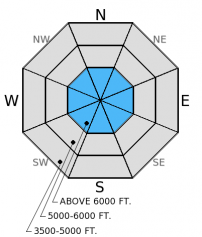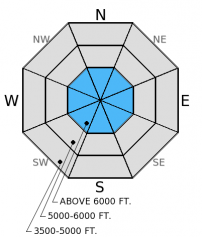| Thursday | Thursday Night | Friday | |
|---|---|---|---|
| Cloud Cover: | Light rain showers. Cloudy. | Clearing. | Mostly sunny. |
| Temperatures: | 44-54 deg. F. | 29-33 deg. F. | 48-58 deg. F. |
| Wind Direction: | Southwest | Southwest | Southwest |
| Wind Speed: | 6-10 mph with gusts to 21 mph. | 5-6 mph with gusts to 17 mph. | 4-5 mph. |
| Snowfall: | 0 in. | 0 in. | 0 in. |
| Snow Line: |
Whitefish Range
Swan Range
Flathead Range and Glacier National Park
How to read the forecast
The hazard above 6000 feet is MODERATE on slopes steeper than 35 degrees due to above freezing temperatures over the past 48 hours and light rain on snow today. All other terrain is rated LOW. Wet snow avalanches are possible on steep slopes as rain weakens the surface snow. Continued warm temperatures and rain may also reawaken deeper weak layers in isolated areas. Evaluate steep slopes carefully today and watch for obvious signs of wet snow instability.

2. Moderate
?
Above 6500 ft.
1. Low
?
5000-6500 ft.
1. Low
?
3500-5000 ft.
- 1. Low
- 2. Moderate
- 3. Considerable
- 4. High
- 5. Extreme
-
Type ?
-
Aspect/Elevation ?

-
Likelihood ?CertainVery LikelyLikelyPossible
 Unlikely
Unlikely -
Size ?HistoricVery LargeLargeSmall

Above freezing temperatures over the past 48 hours and a bit of rain on snow today will keep the wet snow hazard alive. Wet, loose avalanches occurred over the past several days on sunny aspects due to abundant sunshine and above freezing temperatures. Rain on snow will be the catalyst for this type of avalanche today on any aspect. We could see human triggered wet loose avalanches today, particularly on steep slopes. Manage this hazard by moving off of slopes when the surface snow becomes wet. Signs of wet snow instability include roller balls and pin wheels, and rain on snow can cause this instability to change quickly.
-
Type ?
-
Aspect/Elevation ?

-
Likelihood ?CertainVery LikelyLikelyPossible
 Unlikely
Unlikely -
Size ?HistoricVery LargeLargeSmall

The persistent slab problem is back, but it's isolated. The only place we found the late January crust layer to be recently reactive in stability tests is the southern Whitefish Range. This layer still exists in other ranges throughout the advisory area, but has only fractured and propagated in isolated locations (like yesterday). We have not observed or received reports of an avalanche on this layer in over a month. Why is it back on the problem list? Our stability test scores show that is again becoming easier for this layer to fracture and propagate across a column with these recent warm, springlike conditions. Triggering an avalanche on this layer is unlikely, but not impossible. It could manifest as a dry or wet slab avalanche. Recent warming and intense sunshine may have reawakened this layer. This makes it important to dig into the snowpack and identify this layer about 1.5-2.5 feet deep and perform a stability test to determine its reactivity. Assess all slopes particularly steep, rocky areas with a shallow snowpack where you are more likely to trigger an avalanche on this layer. Also, evaluate layers closer to the surface like the mid-February crust for any potential instabilities.
Additional Concerns:Glide avalanches are also possible, but since glide cracks are not widespread and easy to identify they are not a major problem. However, there are enough glide cracks out there to watch out for, particularly in the Swan and Whitefish Ranges. Some glide cracks fail catastropically to the ground while others melt in place. The best way to manage them is to just avoid being on or under slopes with glide cracks.
The next regularly scheduled advisory will be issued Saturday, March 14, 2015.
The above normal temperatures and ample sunshine over the past few days caused small wet, loose avalanches on sunny aspects. Since then only a couple of stations report just below freezing temperatures. Yesterday in the southern Whitefish Range we found the surface snow to support us on skis, but when we removed our skis to dig a pit we instantly sank up to our thighs. This was a bit concerning, and so were our extended column test results (video). On a 35 degree east facing slope we found the late January crust/surface hoar layer, and it fractured and propagated in every test on that slope. We found this layer to propagate with much easier force than just five days ago in a nearby location. It appears the recent warming and solar input were beginning to affect this lingering weakness. On a southerly aspect not too far away, we found a strong and stable snowpack.
On sunny and warm Tuesday in the Marion Lake area of the Flathead Range we found good corn skiing earlier in the day, but by noon the snow surface became quite soft and "punchy" on sunny aspects. The most shaded aspects still harbored soft surface snow in the form of near surface facets (recrystallized "powder"). This is not a problem now, but could become one if we ever get more snow and a slab forms above this layer.
We also observed glide cracks becoming larger in numerous locations throughout the advisory area over the past few days (photo1, photo2). Some glide cracks already failed earlier this season, but others remain in place.
Light precipitation will continue this morning before tapering with snow levels hovering around 6500 feet. Sunny and warm conditions expected tomorrow. As of 4:00 a.m. temperatures above 6000 feet range from 30º-39º F with winds out of the south-southwest at 3-8 mph gusting to 15 mph. Winds over the past 24 hours ranged from 4-10 mph with gusts to 26 mph. Today, temperatures will rise to the mid-40s F with winds moving out of the southwest at 5-15 mph with gusts to 30 mph.
| 0600 temperature: | 30-39 deg. F. |
| Max. temperature in the last 24 hours: | 39-49 deg. F. |
| Average wind direction during the last 24 hours: | Southwest |
| Average wind speed during the last 24 hours: | 4-10 mph |
| Maximum wind gust in the last 24 hours: | 19-26 mph |
| New snowfall in the last 24 hours: | 0 inches |
| Total snow depth: | 60-89 inches |
This advisory applies only to backcountry areas outside established ski area boundaries. This advisory describes general avalanche conditions and local variations always occur. This advisory expires at midnight on the posted day unless otherwise noted. The information in this advisory is provided by the USDA Forest Service who is solely responsible for its content.



























